初中九年级英语教案_u5t3sd
- 格式:docx
- 大小:16.32 KB
- 文档页数:3
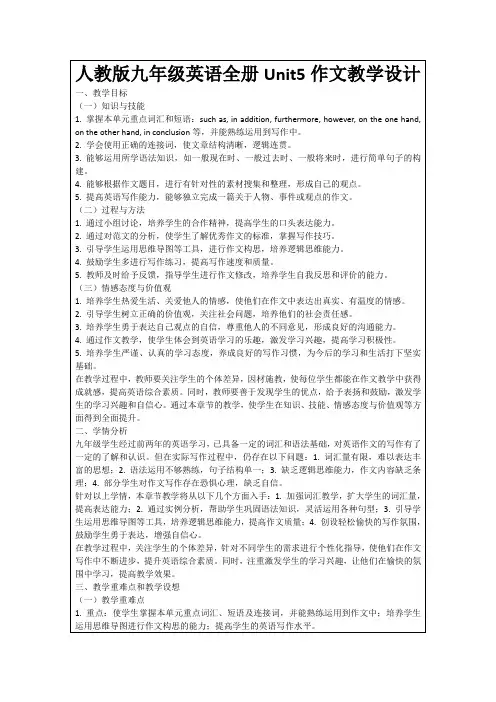
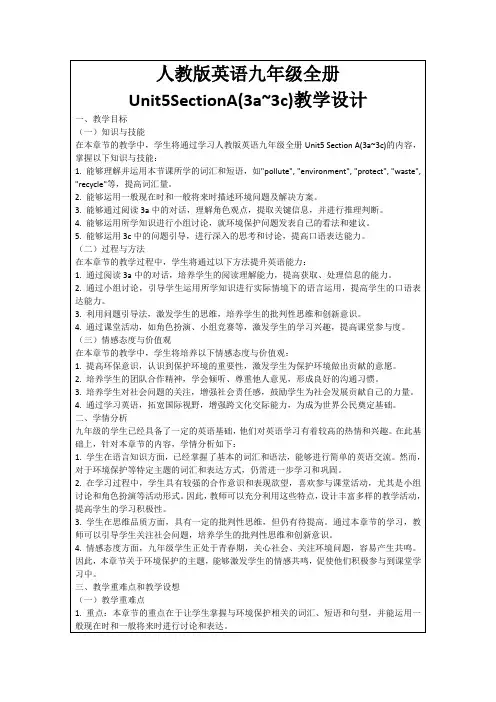
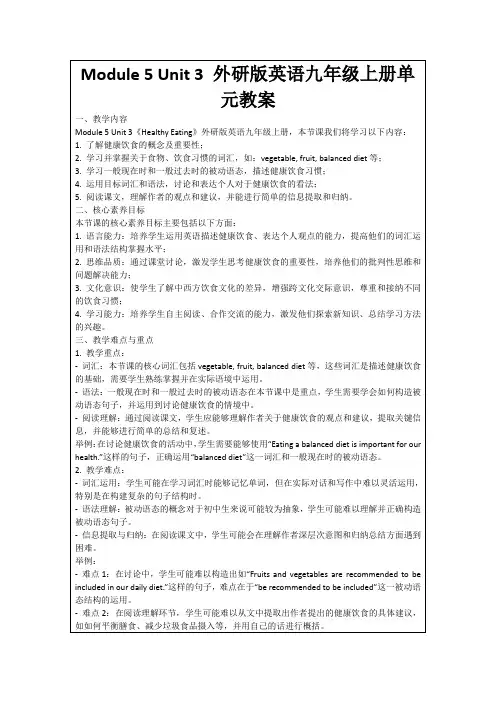
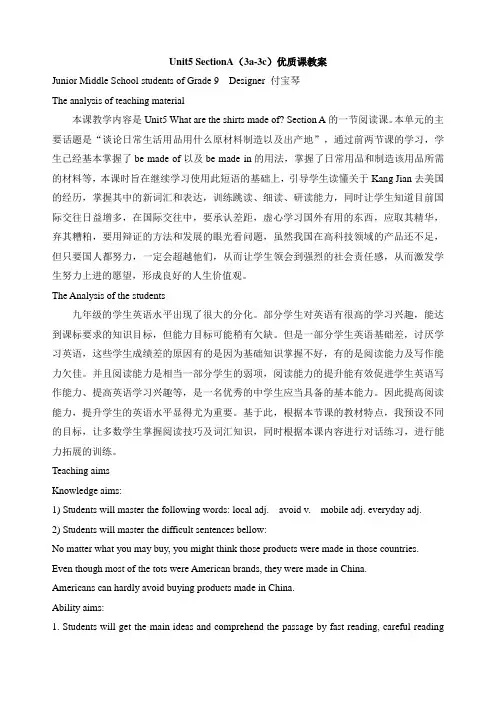
Unit5 SectionA(3a-3c)优质课教案Junior Middle School students of Grade 9 Designer 付宝琴The analysis of teaching material本课教学内容是Unit5 What are the shirts made of? Section A的一节阅读课。
本单元的主要话题是“谈论日常生活用品用什么原材料制造以及出产地”,通过前两节课的学习,学生已经基本掌握了be made of以及be made in的用法,掌握了日常用品和制造该用品所需的材料等,本课时旨在继续学习使用此短语的基础上,引导学生读懂关于Kang Jian去美国的经历,掌握其中的新词汇和表达,训练跳读、细读、研读能力,同时让学生知道目前国际交往日益增多,在国际交往中,要承认差距,虚心学习国外有用的东西,应取其精华,弃其糟粕,要用辩证的方法和发展的眼光看问题,虽然我国在高科技领域的产品还不足,但只要国人都努力,一定会超越他们,从而让学生领会到强烈的社会责任感,从而激发学生努力上进的愿望,形成良好的人生价值观。
The Analysis of the students九年级的学生英语水平出现了很大的分化。
部分学生对英语有很高的学习兴趣,能达到课标要求的知识目标,但能力目标可能稍有欠缺。
但是一部分学生英语基础差,讨厌学习英语,这些学生成绩差的原因有的是因为基础知识掌握不好,有的是阅读能力及写作能力欠佳。
并且阅读能力是相当一部分学生的弱项,阅读能力的提升能有效促进学生英语写作能力、提高英语学习兴趣等,是一名优秀的中学生应当具备的基本能力。
因此提高阅读能力,提升学生的英语水平显得尤为重要。
基于此,根据本节课的教材特点,我预设不同的目标,让多数学生掌握阅读技巧及词汇知识,同时根据本课内容进行对话练习,进行能力拓展的训练。
Teaching aimsKnowledge aims:1) Students will master the following words: local adj. avoid v. mobile adj. everyday adj.2) Students will master the difficult sentences bellow:No matter what you may buy, you might think those products were made in those countries. Even though most of the tots were American brands, they were made in China.Americans can hardly avoid buying products made in China.Ability aims:1. Students will get the main ideas and comprehend the passage by fast reading, careful readingand doing some reading practice.2. Students will retell the passage according to the blackboard design freely.Moral aims:Students believe that China will get better at making high-technology products that people can buy in all parts of the world. And students also know that no matter who they are, they should try their best to make the country stronger and stronger.Teaching key points and difficult points:Teaching key points1) Students will master the key words and phrases.2) Students will get the main ideas and comprehend the passage by fast reading, careful reading and doing some reading practice.Teaching difficult pointsMake up the conversation according to the passage like this:I: Hi! Kang Jian. May I ask you some questions?K: Sure. It’s my pleasure.I: OK, I see. Thanks a lot.K: You are welcome.Teaching methods and learning methods.本课为一节阅读课。
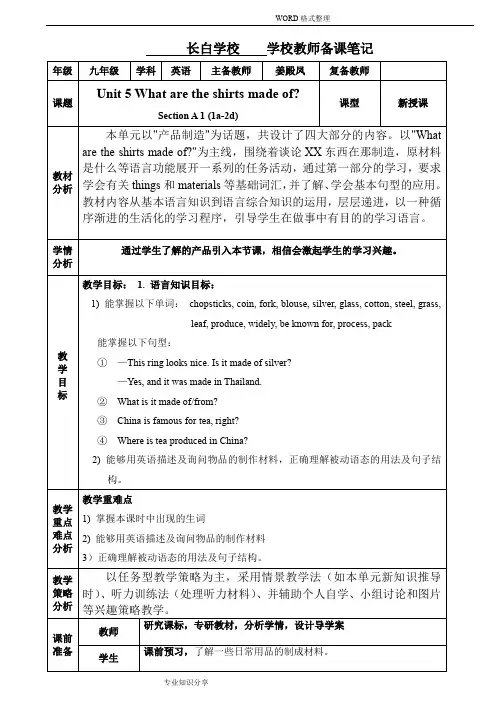

The Third Period—Section B(1a-1e)Teaching Important Points 【教学重点】Key words & phrases:international,find out,fly a kiteKey sentences:1.The international kite festival is held in Weifang every year.2.Some of the kites were made of silk or paper.3.Some were painted with colorful drawings.Key structure:be+past participle verb+…eg:What are kites made of?Teaching Difficult Points 【教学难点】★Talk about what kites are made of in the listening and speaking practice.Teaching Aids 【教学工具】A tape recorder,pictures of kites and used materials,CAI or multimedia courseware.Teaching Steps 【教学过程】★Step 1Leading in 【新课导入】1.Greeting2.BrainstormingShow different things which kites can be made of/from.Help students to review and learn new words.3.Ask students to think of anything a kite may look like.★Step 2Cooperative inquiry 【合作探究】1.Finish the task in 1a①Think of different materials that can be used in making kites in English.②Read aloud the words.2.Finish the task in 1b3.Finish the task in 1c①Lo ok at the five sentences with blanks in 1c.②Play the recording for the second time.Students write L or Z in the blanks.③Ask them to find the sentences having the same or similar meaning in the listening.4.Finish the task in 1d5.Finish the task in 1e①R ead the sample conversation in 1e.②Write some key words on the board to help.Students work in pairs.Role-play.③Act out their conversations to the class.④For the poor students,the teacher can help them with the questions.And get them to answer.★Step 3Homework1.Role-play the conversation like that in 1e after class.2.Write a short passage about Weifang kite festival.3.Translate the following sentences into English.(1)山东潍坊每年都举行国际风筝节。
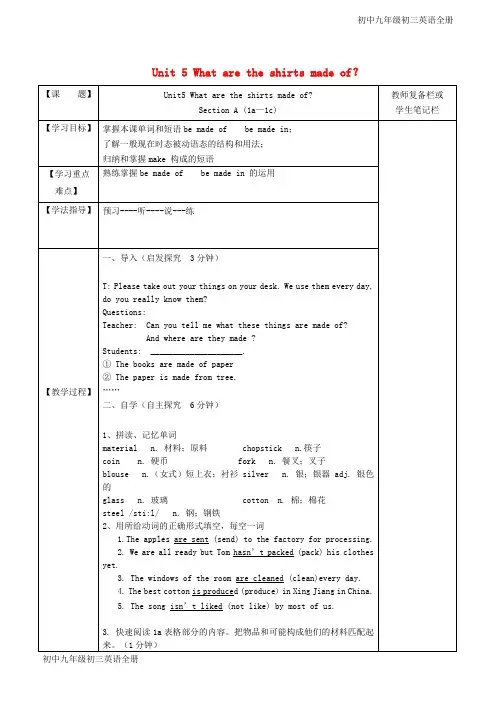
Unit 5 What are the shirts made of?【课题】Unit5 What are the shirts made of?Section A (1a—1c) 教师复备栏或学生笔记栏【学习目标】掌握本课单词和短语be made of be made in;了解一般现在时态被动语态的结构和用法;归纳和掌握make 构成的短语【学习重点难点】熟练掌握be made of be made in 的运用【学法指导】预习----听----说---练【教学过程】一、导入(启发探究 3分钟)T: Please take out your things on your desk. We use them every day, do you really know them?Questions:Teacher: Can you tell me what these things are made of?And where are they made ?Students: _____________________.① The books are made of paper② The paper is made from tree.……二、自学(自主探究 6分钟)1、拼读、记忆单词material n. 材料;原料 chopstick n.筷子coin n. 硬币 fork n. 餐叉;叉子blouse n.(女式)短上衣;衬衫 silver n. 银;银器adj. 银色的glass n. 玻璃 cotton n. 棉;棉花steel /sti:l/ n. 钢;钢铁2、用所给动词的正确形式填空,每空一词1.The apples are sent (send) to the factory for processing.2. We are all ready but Tom hasn’t packed (pack) his clothes yet.3. The windows of the room are cleaned (clean)every day.4. The best cotton is produced (produce) in Xing Jiang in China.5. The song isn’t liked (not like) by most of us.3. 快速阅读1a表格部分的内容。

人教版英语九年级全一册教案:Unit5 SectionA(3a-3c)Unit5SectionA〔3a-3c〕教案【教材版本与册数】新目标人教版九年级上册【单元名称】Unit 5 What are the shirts made of ?【课时】Section A 3a-3c 〔第2课时〕教材分析【本单元话题】本单元以中国制造的东西为话题,以谈论中国的物产及其产地为交际功能,重点在这些语境中学习和运用了一般现在时的被动语态。
【本单元重点掌握目标】掌握一般现在时的被动语态结构:am/is/are+PP【教材内容拆分分析】Section A从与日常生活相关的词汇入手,开展了简单的物产及产地的会话和阅读活动,并在表达中穿插了被动语态的陈述句、一般疑问句句、反义疑问句和否认句的使用。
3a-3c是阅读训练任务链活动。
本篇短文讲述的是一个中学生在美国的商店中找不到美国制造的产品,而几乎都是中国制造的事实,进一步扩大和稳固日常词汇,呈现更多本单元要求学习和掌握的被动语态句型,让青少年了解当今世界制造格局,同时在文章结尾处指出了我国在世界经济竞争中缺乏之处,让他们知道在高科技领域的产品还不能与他人比肩同行。
【通过本单元的学习学生需掌握哪些综合技能】通过本单元的学习使学生学会谈论不同的东西及其制成的材料,掌握教材所呈现的与各种东西及原材料主题相关的单词和一般现在时被动语态,阅读含有一般现在时态的被动语态的短文并进行正确理解。
教学目标语言知识目标:1.通过与学生完成阅读,读懂文章大意,学习和掌握以下词汇、短语与句型并能熟练运用。
单词:France, local, brand, avoid, product, handbag, mobile, everyday短语:no matter, search for句型:1〕No matter what you may buy, you might think those products were made in those countries.2) He found it interesting that so many products in the local shops were made inChina.3) Kang J ian thinks it’s great that China is so good at making these everydaythings.2.阅读训练:通过阅读短文,能按要求找到相应的信息,提高学生们的阅读能力。
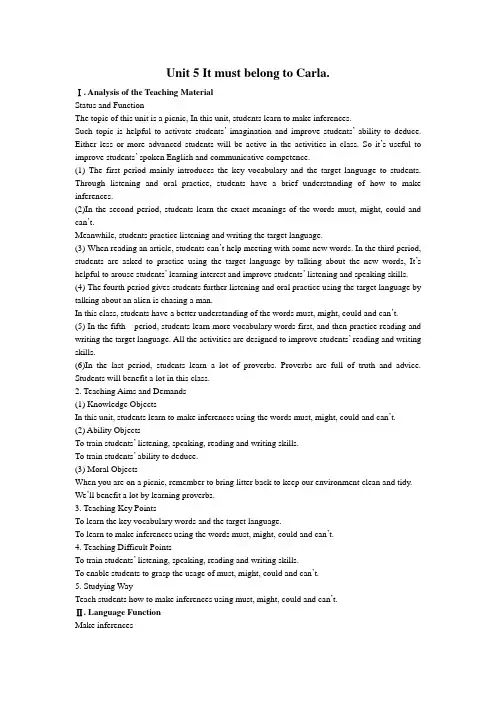
Unit 5 It must belong to Carla.Ⅰ. Analysis of the Teaching MaterialStatus and FunctionThe topic of this unit is a picnic, In this unit, students learn to make inferences.Such topic is helpful to activate students’imagination and improve students’ability to deduce. Either less or more advanced students will be active in the activities in class. So it’s useful to improve students’ spoken English and communicative competence.(1) The first period mainly introduces the key vocabulary and the target language to students. Through listening and oral practice, students have a brief understanding of how to make inferences.(2)In the second period, students learn the exact meanings of the words must, might, could and can’t.Meanwhile, students practice listening and writing the target language.(3) When reading an article, students can’t help meeting with some new words. In the third period, students are asked to practise using the target language by talking about the new words, It’s helpful to arouse students’ learning interest and improve students’ listening and speaking skills. (4) The fourth period gives students further listening and oral practice using the target language by talking about an alien is chasing a man.In this class, students have a better understanding of the words must, might, could and can’t. (5) In the fifth period, students learn more vocabulary words first, and then practice reading and writing the target language. All the activities are designed to improve students’ reading and writing skills.(6)In the last period, students learn a lot of proverbs. Proverbs are full of truth and advice. Students will benefit a lot in this class.2. Teaching Aims and Demands(1) Knowledge ObjectsIn this unit, students learn to make inferences using the words must, might, could and can’t. (2) Ability ObjectsTo train students’ listening, speaking, reading and writing skills.To train students’ ability to deduce.(3) Moral ObjectsWhen you are on a picnic, remember to bring litter back to keep our environment clean and tidy. We’ll benefit a lot by learning proverbs.3. Teaching Key PointsTo learn the key vocabulary words and the target language.To learn to make inferences using the words must, might, could and can’t.4. Teaching Difficult PointsTo train students’ listening, speaking, reading and writing skills.To enable students to grasp the usage of must, might, could and can’t.5. Studying WayTeach students how to make inferences using must, might, could and can’t.Ⅱ. Language FunctionMake inferencesⅢ. Target LanguageWhose volleyball is this?It must be Carla’s. She loves volleyball.It could be Ted’s.Ⅳ. Structuremust, might, could and can’tⅤ. Vocabularypicnic, chase, escape, belong to, toy car, plate’, mystery, appointment, worried, wake, neighbor, garbageⅥ. Recyclingsuit, land, volleyball, magazine, book, CD, bat, earring, T-shirt, UFO, whose, owner, exercise, dream, anxiousⅦ. Learning Strategies1. Sequencing2. DeducingⅧ. Teaching TimeSix periodsThe First PeriodI. Teaching Aims and Demands1. Knowledge Objects(1) Key V ocabularybelong, belong to, plate, author, toy, picnic(2)Target LanguageWhose book is this?It must be Mary’s. Wanda Wilbur is her favourite author.2. Ability Objects(1) Train students’ listening skill.(2) Train students’ communicative competence using the target language.3. Moral ObjectsWhen you are on a picnic, remember to bring litter back to keep our environment clean and tidy. Ⅱ.Teaching Key Points1. Key vocabulary2. Target languageⅢ.Teaching ProceduresStep I RevisionCheck homework. Invite different students to say the answers to the exercises on pages 12~14 of the workbook.Step Ⅱ1aThis activity introduces the key vocabulary.Write the key vocabulary words on the blackboard. Say the words one by one and have students repeat several times until they can read them fluently and accurately.Ask different students to explain in their own words the meanings of the words belong to, author and picnic.Belong means to be owned by somebody.An author is a writer of a book or a play.A picnic is a meal eaten out of doors.Then invite two students to draw a plate next to the word plate and a toy car next to toy.Focus attention on the picture. Have students point to each item and say its name. Call students attention to the chart with the headlines clothing. Funthings and kitchen things at the top. Invite different students to explain the meanings of the column heads.Say, Please look at the picture and write the things you see in the correct columns in the chart. Point out the sample answers. Get students to complete the task on their own. As they work, move around the room checking their progress and answering any questions they may have.Show the correct answers on the screen by a projector.Step ⅢlbThis activity gives students practice in understanding the target langugage in spoken conversation. Call students’ attention to the chart. Set a time limit of two minutes. Students read the persons, the things and the reasons.Say, You will hear a conversation. As you listen, draw lines to connect the person in the first column with the thing in the second column. Then draw another line to connect the thing in the second line with the reason in the third column.Point out the sample answer. Say, The name Carla in the first column connects to volleyball in the second column because that’s the thing they are talking about. And the word volleyball in the second column connects with the sentence she loves volleyball in the third column.Play the recording the first time.Students only listen. Play the recording again. This time students listen and match each person with a thing and a reason.Check the answers.Step Ⅳ1cThis activity provides oral practice using the target language.Point to the picture in Activity lb. Invite pair of students to say the conversation in the speech bubbles.Point out the conversation in the box. Invite another pair of students to say it to the class. S A : Whose book is this?S B: It must be Mary’s. Wanda Wilbur is her favourite author.Write the conversation on the blackboard.Point out the chart in Activity 1b. Say.Now work with a partner. Start by reading the conversations in the picture and in the box: Then make conversations using the information in the chart in Activity 1b. Talk about who each thing might belong to and give a reason. Get students to practice in pairs. As they work, move around the classroom listening in on various pairs and offering help with language and pronunciation as needed.After all the students have had an opportunity to ask and answer questions, stop the activity. Get different pairs of students to say their conversations to the class.Step ⅤSummarySay, In this class, we’ve learned the key vocabulary words belong to, plate, author, toy and picnic and done much listening and oral practice using the target language.Step ⅥHomework(1) Say and remember the spelling of the vocabulary words.(2)Say the conversations in Activity 1c to get a further understanding of the target language.Unit 5 It must belong to Carla.The Second PeriodI. Teaching Aims and Demands1. Knowledge Objects(1) Key V ocabularydrop, symphony, optometrist, appointment, algebra, crucial, count, because of, Chinese-English dictionary, Oxford University(2) Target LanguageWhat do you think "anxious" means?Well, it can’t mean "happy".It might mean "worried".Oh, yes, she is worried because of her test.Here are some earrings. The owner can’t be a boy.Well, it could be a boy. The earrings might be a present for his mother.2. Ability Objects(1) Train students’ reading skill.(2) Train students’ communicative competence using the target language.Moral ObjectWhen you are in trouble, send an e-mail message to your friends to ask for help.Ⅱ. Teaching Key Points1.Reading practice2.Oral practice using the target languageⅢ. Teaching Difficult Points1. Key vocabulary2. Target languageⅣ. Teaching ProceduresStep I RevisionRevise the usage of the words must, might, could and can’t by checking homework.Ask students to exchange their exercises books and help correct any errors with each other, As they are doing this, move around the classroom offering language support as needed. Then invite different students to say their sentences to the class.Step Ⅱ3aThis activity provides reading practice using the target language.Call students’attention to the picture.Ask students to tell what’s happening in the picture.T: What’s the girl doing?S s: She is using the computer to write e-mail.Point to the parts of the e-mail message.Tell students that this is the message the girl in the picture writes. Say, Right now the parts are in the wrong order. When they are in the right order, they will make a clear message. Now please read the parts carefully. Number them in order. When you are doing this, you will meet with some words you don’t know.Don’t worry too much about them. Just circle them. We’ll talk about what they mean later.Get students to complete the task on their own. Point out the sample answer.Say. The first sentence of the e-mail message is I’m really anxious, because I can’t find my backpack.Check the answers.Step Ⅲ3bThis activity provides oral practice using the target language.Read the instructions to the class. Point to the sample conversation. Invite a pair of students to say it to the class.S A: What do you think "anxious" mean? S B: Well, it can’t mean "happy".S A: It might mean "worried". S B: Oh, yes. She is worried because of her test.Write the conversation on the blackboard.Say, You are to talk about the circled words in Activity 3a. Use the words can’t, must, could or might as in the sample.Get students to work with a partner. As they work in pairs, move around the classroom helping students with pronunciation and answering any questions they may have. Some time later, stop the activity. Ask different students to share their conversations with the class. Make a list of the words students are talking about on the blackboard.Practice the pronunciation of these words and explain the meaning of each word. Step ⅣPart 4This activity provides oral practice using the target language.Call students’ attention to the picture. Get students to name each item in it.Write the new words Chinese-English dictionary and Oxford University on the blackboard. Point to the sample conversation. Invite a pair of students to read it to the class.Write the conversation on the black board. Explain the meaning of each sentence. Focus attention on the chart with the headlines Can’t, Could/might and Must at the top. Point out the sample answer.Read the instructions to the class.Get students to complete the task in pairs. As the pairs work together, move around the classroom helping students with pronunciation, sentence formation or anything else they ask for help with.Ask some pairs to say their conversations to the class.Note: Answers to the chart will vary.Step ⅤSummarySay, In this class, we’ve learned some vocabulary words, such as drop, symphony.And we’ve done much oral practice using the target language.Step ⅥHomework1. Read the letter in Activity 3a again for further understanding of the vocabularywords.2. Read the conversations in Activities 3b and 4 again for further understanding of the target language.3. Finish off the exercises on pages 15~16 of the workbook.The Third PeriodI. Teaching Aims and Demands1. Knowledge Objects(1) Key Vocabulary:chase, creature(2) Target LanguageWhy do you think the man is running?He could be running for exercise.No, he’s wearing a suit. He might be running to catch a bus.2. Ability Objects(1)Train students’ listening skill.(2)Train students’ writing skill.3. Moral ObjectThe UFO and alien are both unreal. As students, we must work hard to explore the universe in the future.Ⅱ. Teaching Key Points1. Listening practice2. Writing practiceⅢ. Teaching Difficult Points1. Write a sentence about each picture.2. Write two or three sentences to finish the story.3. Listen and complete the sentences.Ⅳ. Teaching ProceduresStep ⅠRevision1. Invite a student to read the thank you message Linda wrote to Anna to the class.2. Get different pairs of students to read the conversations in Activities 3band 4.3. Check answers to the exercises on pages 15~16 of the workbook.StepⅡPart lThis activity provides writing practice using the target language.Read the instructions to the class. Read the words in the box and have students repeat several times. Invite different students to explain the meaning of each word in their own words.Get students to look at the three pictures carefully. Say, You are to use the words from the box to write a sentence about each picture. Point out where to write the sentences. Ask a student to say the sample answer to the class. Get students to complete the activity individually. As students work, walk around the classroom offering language support as needed.Check the answers on the blackboard.Step Ⅲ2aThis activity gives students practice understanding and writing the target language in spoken conversation.Read the instructions to the class. Point to the three pictures in Activity 1. Say, You will hear a conversation about these pictures. As you listen, write a number in the box in the left corner of each picture to show the order of the events.Point out the sample answer in the box of the third picture. Say, You will hear the man is running first. Play the recording the first time. Students only listen. Play the recording again. This time students listen and number the pictures. Encourage students to write two or three sentences to finish the story.Answers will vary. Write a sample version on the blackboard. Ask students to use it as a model.Step Ⅳ2bThis activity gives students practice listening to and writing the target language.Point to the chart with sentence startersThey see …The man says…and The woman says…Say, You are to listento the same recording again. And complete each sentence.Point out the sample answers. Say, They see a man running. The man says he could be running for exercise. The woman says he might be late for work. Explain the meaning of the word creature to the students.Play the recording once or twice, using the Pause button as necessary.Show the answers on the screen by a projector so thatStep Ⅴ2cThis activity provides oral practice using the target languagePoint out the sample conversation in the box. Invite a pair of students to read it to the class.S A: Why do you think the man is running?S B: He could be running for exercise.S A: No, he’s wearing a suit. He might be running to catch a bus.Write it on the blackboard.Say, Now work with a partner. Start by reading the conversation in the box with your partner. Then role play conversations using information in Activity 2b.Get students to work in pairs. As the pairs work together, walk around the classroom listening in on various pairs and offering help needed. Ask several pairs to say their conversations to the class.Step ⅥSummarySay, In this class, we’ve mainly done much listening and writing practice using the target language.Step ⅦHomeworkAsk students to collect pictures of different kinds and then talk about them using must, could, might and can’t.The Fourth PeriodI. Teaching Aims and Demands1. Knowledge Objects(1) Key Vocabularyextremely, worried, neighbor, garbage, mystery, director, escape, ocean(2) Target LanguageIn my dream, I was swimming in an ocean of paper.Maybe it means you’re afraid of too much homework!2. Ability Objects(1) Train students’ reading skill. (2) Train students’ writing skill.(3) Train students’ integrating skills.3. Moral ObjectEveryone has had a dream. But don’t dream away your time.Ⅱ. Teaching Key Points1. Key vocabulary2. Reading practice3. Writing practiceⅢ. Teaching Difficult Points1. Reading practice2. Writing practiceⅣ. Teaching ProceduresStep ⅠRevisionCheck homework.Collect pictures from students on the teacher’s desk. Hold up one at a time and ask students to describe it using the target language introduced in the preceding classes. For example:T: (Holding up a picture with a boy swimming in an ocean of books) What do you think is happening to the person in the picture?S1: He must be a student. S2: He could be having a dream. S3: He might like reading books. Step Ⅱ3aThis activity provides reading practice using the target language.Show the key vocabulary words on page 38 on the screen by a projector.Say the words one by one and have students repeat several times until they can pronounce them fluently and accurately. Read the title of the newspaper article strange events in Bell Tower neighborhood to the class. And then point to the picture and ask students. How is the person feeling? Help students to answer. He is confused and upset.Call students’ attention to the article. Read it to the class. Say, Now please read the article individually and underline what people think could be causing the strange things that are happening in Bell Tower. Point out the sample answer.Get students to complete the task individually. As they work, walk around the classroom answering any questions they may have and offering help as needed. Check the answers.Answersan animal, teenagers, the wind, a dogStep Ⅲ3bThis activity provides reading and writing practice using the target language.Get students to discuss any words or sentences they don’t know in Activity 3a with one another. Call students’attention to the three sets of notes. Ask different students to read them to the class.Chu family--late night footsteps in the hallway--might be the neighborsLao Zheng--someone trying to get in the window--might be the windXiao Ning--finds garbage in front of her house--might be catsSay, You are to write another paragraph about Bell Town using these notes. You may use the article inActivity 3a as a model. Ask students to write their paragraphs on their own in the exercise books. As they work, move around the classroom offering language support as needed. Get a few students to read their works to the class. Answers will vary. Write the sample version on the blackboard.Step Ⅳ3cThis activity provides writing practice using the target language.Read the title No more mystery in Bell Tower neighborhood to the class and explain the meaning of the word mystery. Invite a student to read the opening sentences to the class. Divide the class in to groups of four to discuss what should be included in the article.Two or three minutes later, stop the activity. Say, Now please finish the article about the strange events in Bell Tower. Use the ideas you discussed along with original ideas of your own to complete the article. Get students to complete the task on their own in the exercise books. As they are writing, move around the classroom offering help as needed. Ask some students to read their articles to the class.Collect students’ works and write a comment on each paper before returning them.Step ⅤPart 4This activity provides reading, writing, listening and speaking practice using the target language. Read the instructions to the class. Point to the picture. Ask students to tell what is happening in it. Invite a pair of students to read the sample conversation in the box to the class.Say, Once I had a dream. In my dream, I was eating a state dinner. What might the dream mean? Students may answer.Maybe it means you are too hungry. Say. Think of a dream you had recently and tell your classmates about it Your classmates guess what the dream might mean. Please work with a partner. Start practice by reading the sample conversation. As the pairs work together, walk around the room offering help with pronunciation and language. Ask different pairs to tell the class about their dream and what they may mean.Step ⅥSummarySay, In this class, we’ve mainly done much reading and writing practice using the target language. We’ve learned some vocabulary words as well.Step ⅦHomework1. Reread the newspaper article in Activity 3a.2. Review the paragraph in Activity 3b,The Fifth PeriodI. Teaching Aims and Demands1. Knowledge Objects(1)Key Vocabularyfinger, stone, ant, poor, dishonest, bark, wake, pretend, use up, attempt(2)Fill in blanks and make sentences using vocabulary words.(3)Learn some proverbs.(4)Circle the word that doesn’t belong.2. Ability Objects(1)Train students’ writing skill.(2)Train students’ ability of reading comprehension.(3)Train students’ ability of clarifying.3. Moral ObjectWe’ll benefit a lot by learning proverbs.Ⅱ. Teaching Key Points1. Make sentences using vocabulary words.2. Say the meanings of different proverbs in your own words.3. Circle the word that doesn’t belong.Ⅲ. Teaching Difficult Points1. Make sentences using vocabulary words.2. Say the meanings of different proverbs in your own words.Ⅳ.Teaching ProceduresStep ⅠRevisionAsk several students to read the newspaper article in Activity 3a to the class.Step ⅡPart 1This activity provides a comprehensive review of vocabulary presented in the unit.of the word, for example adjusting for tense or subject/verb agreement.Ask students to fill in the blanks on their Own.Check the answers. Five students each read a sentence, filling in the blanks. The rest of the students check their answers.Answers1. favourite2. careful3. anxious4. worried5. strangeAsk students to make their own sentences with the words, preferably sentences that are meaningful. Move around the room. Collect a few students’answers with mistakes on the blackboard.Help correct the mistakes.Sample answers1. What’s your favourite song?2. Be careful while crossing a road.3. We are anxious for his safety.4. You don’t have to be worried about me.5. I had a strange dream last night.Step ⅢPart 2This activity provides reading, writing, listening and speaking practice using the target language. Show the vocabulary words on the screen by a projector.Say the words and have students repeat them until they can pronounce them fluently and accurately. Read the instructions to the class. Explain to the students that a proverb is a short well-known saying that states a general truth or gives advice.Read the first proverb to the class. One finger cannot lift a small stone. Elicit the interpretation from the students(It’s better to have help to do even small jobs).Say, Please read the proverbs, Discuss with your classmates what they might mean.Get students to work in groups of four.As the groups work together, walk around the room to make sure that students are discussing the topic in English. Invite different students to say what they think each proverb means.There can be more than one interpretation for each proverb. Check the answers by showing the sample answers on the screen by a projector.Step ⅥPart 3This activity focuses on the new vocabulary introduced in this unit.Ask students to read the five lines of words in the box.Point out the first line. In this line, escape, chase and run are all verbs. However, the word owner is a noun. So we circle it. Now please circle the word that doesn’t belong in each line.Get students to complete the task on their own. As they are doing this, move aroundthe classroom checking their progress and offering help as needed.Check the answers by asking a student to read his or her circled words to the class. Answers :1. owner 2. alien 3. land 4. exercise 5. lostStep ⅤJust for Fun!This activity provides reading and speaking practice with the target language.Ask all the students to read the cartoon story. Ask students why it is funny. Help students to answer. The boys think they are going to land on an island. Instead, they have landed on the back of a whale.Step ⅥSummarySay. In this class, we’ve practiced filling in blanks and making sentences with some vocabulary words introduced in this unit. And we’ve learned several proverbs.StepⅦHomework(1) Read and remember the proverbs learned in Activity 2.(2) Each student collects ten proverbs.(3) Finish off the exercises on pages 16~17,of the workbook.Step Ⅷ。
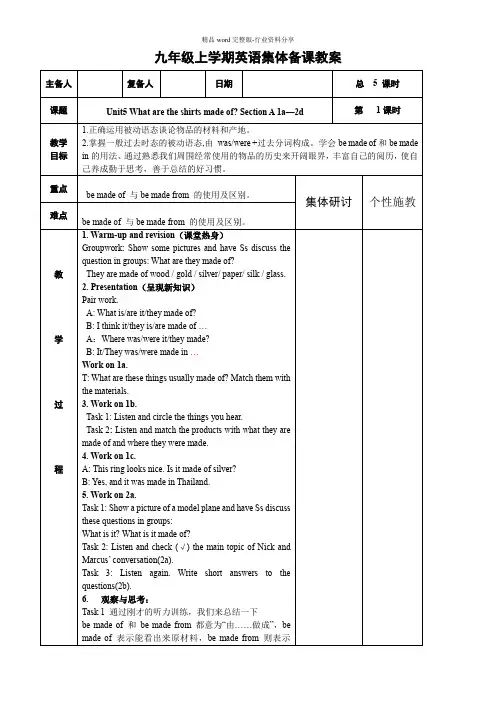
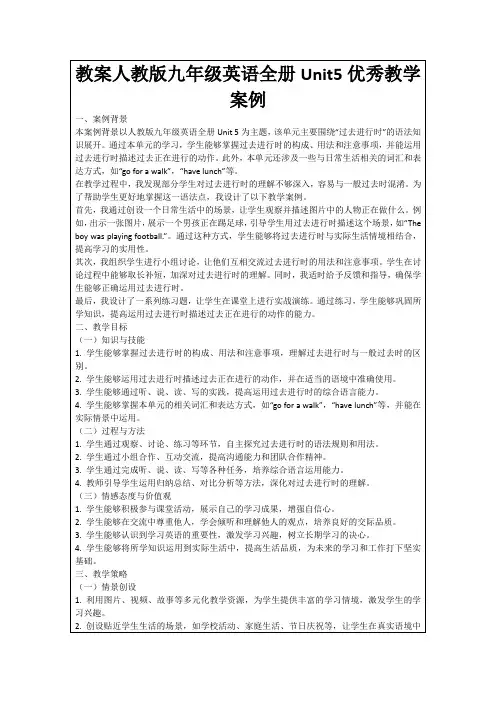
Module5 MuseumsUnit3 Language in use单词upstairs, exhibition, rule, against the rule,if引导的条件状语从句。
总结和巩固祈使句的用法以及由if引导的条件状语从句+祈使句的用法。
由if引导的条件状语从句+祈使句的用法。
Step 1完成教材 Activities 1~8 的任务1.Match the signs with the rules. (Activity 1)(1)学生个体活动,浏览标志,进行匹配。
全班核对答案。
(2)小结“No+名词/动词ing”的语言表达方式。
2.Look at the signs and write the rules.(Activity 2)(1)学生个体活动,以“No+名词/动词ing”的形式,写出警示语。
(2)两人一组检査拼写及语句,汇报及核对答案。
(答案:1.Do not touch2.No smoking3.No photos4.No entry)3plete the sentences with the correct form of the words in brackets. (Activity 3) (1)活动开展前,教师要明确主句的要求(用祈使句)和从句动词时态的要求(用一般现在时)。
(2)学生独立完成句子,两人一组检查。
汇报及核对答案。
环节说明:本活动旨在帮助学生巩固if引导的条件状语从句。
本活动采用了控制性的练习方式,主要让学生练习把握“if…do”结构。
4plete the sentences with your own ideas.(1)学生个体活动,充分思考,完成句子。
(2)教师鼓励学生主动作答,每句话都可以让5~6名学生展示汇报,语句合理即成立。
5.Work in pairs. Ask and answer questions about the museum. Now write some advice for visitors. Use If.(Activity 5)(1)学生个体活动,阅读博物馆参观指南。
Unit 5 You’re supposed to shake hands.The Third Period Section A 3a–3cTeaching aims(教学目标)【学习目标】知识目标:能熟练说出和写出本话题的功能句:1. Where I’m from, we’re pretty relaxed about time.2. Often we just walk around the town center, seeing as many of our friends as we can!3. We often just drop by our friends’ homes.4. It’s very important to be on time.5. We usually plan to do something interesting, or go somewhere together. 通过学习,能正确写出本课课标词及短语::value, everyday, capital, noon, mad, traffic, somewhere.理解以下短语: drop by, get mad, make an effort.技能目标:能够运用目标语言谈论不同国家对于时间的不同看法以及与朋友交往的礼仪。
情感态度: 学会比较不同文化的差异,风俗和礼仪,增强人际交往能力。
Di fficulties(难点):通过学习,掌握以下句型:1. Where I’m from, we’re pretty relaxed about time.2. Often we just walk around the town center, seeing as many of our friends as we can!3. We often just dr op by our friends’ homes.4. It’s very important to be on time.5. We usuall y plan to do something interesting, or go somewhere together. 熟练掌握以下词汇:value, everyday, capital, noon, mad, traffic, somewhere. Teaching steps(教学步骤)1. Discuss in groups: What are you supposed to do when you meet people from France for the first time?2. Pair work:A: What are you supposed to do when you meet people fro m France for the first time?B: You are supposed to … when you meet people from France for the first time.教学设计说明:复习旧知,导入新课。